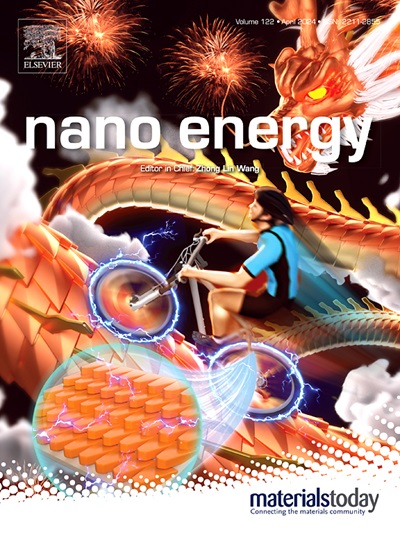金红石Ru0.28Ir0.16Cr0.28Mn0.28O2纳米结构的晶格熵调制加速了ph -通用出氧动力学
IF 16.8
1区 材料科学
Q1 CHEMISTRY, PHYSICAL
引用次数: 0
摘要
单相晶体结构中晶格熵的精细调制是一种很有前途的策略,可以调整各种催化剂的电子结构和催化效率。本文报道了一种新型的单相金红石型Ru0.28Ir0.16Cr0.28Mn0.28O2纳米颗粒,该纳米颗粒采用经济环保的水溶液酸碱滴定共沉淀法合成,随后采用经济高效的后焙烧工艺。这就产生了一种具有成本效益的、非常活跃的、稳定的电催化剂,可以在很宽的pH值范围内用于析氧反应(OER)。Ru、Ir、Cr和Mn元素随机加入到一个四方晶格中,有利于水的快速解离,从而优化了Volmer步骤的动力学,并显著提高了各种电解质条件下的OER性能,包括碱性、酸性甚至神经溶液,过电位分别为275 mV、210 mV和300 mV,电压为10 mA cm-2。此外,Ru0.28Ir0.16Cr0.28Mn0.28O2纳米颗粒在0.5 M H2SO4, 1 M KOH和0.5 M PBS溶液中连续OER操作超过75小时,保持稳定的电位,证实了它们在ph通用条件下超过75小时的优异稳定性。此外,实验结果和理论模拟之间的协同作用表明,优化的能级通过平衡含氧中间体(*OH, *O和*OOH)的吸附和解吸来提高催化性能。这种电子性质的微调促进了高效的OER动力学,从而提高了催化活性。我们的研究结果介绍了一种简单而环保的合成方法,通过调制晶格熵来合成单相金红石型Ru0.28Ir0.16Cr0.28Mn0.28O2纳米颗粒,从而得到独特的晶格结构,可以作为有效的OER催化剂电极。本文章由计算机程序翻译,如有差异,请以英文原文为准。

Modulating Lattice Entropy of Rutile Ru0.28Ir0.16Cr0.28Mn0.28O2 Nanostructures Expedites pH-Universal Oxygen Evolution Kinetics
The fine modulation of lattice entropy in a single-phase crystal structure is a promising strategy for tailoring the electronic structure and catalytic efficiency of various catalysts. We report a novel single-phase rutile-type Ru0.28Ir0.16Cr0.28Mn0.28O2 nanoparticles synthesized via a coprecipitation process employing an economical and eco-friendly acid-base titration in aqueous solution, and subsequently a post-calcination process as a cost-effective. This results in a cost-effective, remarkably active, and stable electrocatalyst for the oxygen evolution reaction (OER) across a wide range of pH levels. The random incorporation of Ru, Ir, Cr, and Mn elements into a single tetragonal lattice facilitates rapid water dissociation, thereby optimizing the kinetics of the Volmer step and significantly enhancing OER performance in various electrolyte conditions, including alkaline, acidic, and even neural solution, with overpotentials of 275 mV, 210 mV, and 300 mV for 10 mA cm-2, respectively. Furthermore, Ru0.28Ir0.16Cr0.28Mn0.28O2 nanoparticles maintain stable potential during continuous OER operation for over 75 hours in 0.5 M H2SO4, 1 M KOH, and 0.5 M PBS solutions, confirming their excellent stability over more than 75 hours under pH-universal conditions. Additionally, the synergy between experimental results and theoretical simulations reveals that the optimized energy levels enhance catalytic performance by balancing the adsorption and desorption of oxygen-containing intermediates (*OH, *O, and *OOH). This fine-tuning of electronic properties facilitates efficient OER kinetics, leading to improved catalytic activity. Our findings introduce a straightforward and environmentally friendly synthetic methodology for a single phase of rutile-type Ru0.28Ir0.16Cr0.28Mn0.28O2 nanoparticles by modulating the lattice entropy, resulting in the unique lattice structure that can be applied as an effective OER catalyst electrode.
求助全文
通过发布文献求助,成功后即可免费获取论文全文。
去求助
来源期刊

Nano Energy
CHEMISTRY, PHYSICAL-NANOSCIENCE & NANOTECHNOLOGY
CiteScore
30.30
自引率
7.40%
发文量
1207
审稿时长
23 days
期刊介绍:
Nano Energy is a multidisciplinary, rapid-publication forum of original peer-reviewed contributions on the science and engineering of nanomaterials and nanodevices used in all forms of energy harvesting, conversion, storage, utilization and policy. Through its mixture of articles, reviews, communications, research news, and information on key developments, Nano Energy provides a comprehensive coverage of this exciting and dynamic field which joins nanoscience and nanotechnology with energy science. The journal is relevant to all those who are interested in nanomaterials solutions to the energy problem.
Nano Energy publishes original experimental and theoretical research on all aspects of energy-related research which utilizes nanomaterials and nanotechnology. Manuscripts of four types are considered: review articles which inform readers of the latest research and advances in energy science; rapid communications which feature exciting research breakthroughs in the field; full-length articles which report comprehensive research developments; and news and opinions which comment on topical issues or express views on the developments in related fields.
 求助内容:
求助内容: 应助结果提醒方式:
应助结果提醒方式:


